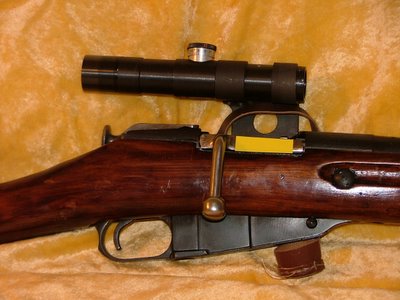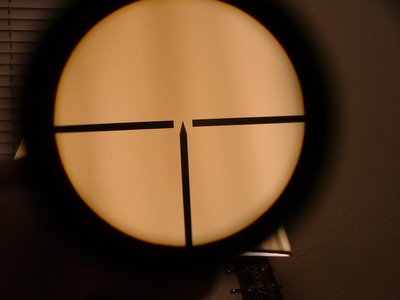This is one of the reasons having a C&R license is a mixed blessing. You get lots of sales flyers with lots of neat stuff to look at, and sometimes buy. Which can cause you to wind up saying "Budget? What budget?"
Case in point. Interordnance had been saying for months that they were going to get in Mosin Nagant PE and PU snipers, and then... they did. And sent me a flyer. And the next day I called, and asked some questions, and decided I'd find a way to rearrange my non-existent budget(please I hope I get a refund this year) because I'd been wanting one of these for years, so...
I present the Mosin Nagant 91/30 PU sniper

in, as Kim puts it, the manly 7.62x54r cartridge, a rimmed design that is still in use by the Russians, both in the SVD sniper rifle and in machine guns. This design was used WWII and after, and was supplied to Soviet client states into the 1970's.
The PE was the earlier version scope, phased out early in WWII; the PU was the replacement, issue starting in 1942. It fits into a side-mount that can be removed from the base and replaced without changing the point of impact.

It's a fixed 3.5x scope, and has no provision for adjusting focus; if your vision is not either naturally perfect or corrected, you will be looking at blurry images. The mount holds it high enough that the iron sights can be used, and the short straight MN bolt handle was replaced with a long, turned-down handle. That leather strap and cup you see is my homemade lens covers, copied from an illustration I found.
Here's the other side of the receiver and the scope assembly

That big screw you see at the back is what locks the mount into place in the base. Back it out, and loosen the top elevation screw, and the mount/scope lift out:

Not visible are the elevation adjusting screws top and bottom; they're in the base above/below the rear of the mount where the lock-screw bears and they're important. Important because while the scope does have elevation/windage turrets, they move the reticle itself in the field of view, so if you need much adjustment you can wind up with the reticle way over to one side and high or low, which is not good. So you center the reticle, and adjust elevation by using the screws to tilt the mount; raise the back to raise the point of impact, lower it to lower POI. Trial and error, but it works quite well. Windage adjustment? Well, no screws. Instead, here's the rear of the mount:

See those two extensions on the right? If, with the mount locked down, the POI is off to the left, you'd file or grind those down just a bit, then mount it back up and test fire, working off just a bit at a time until it's dead-on. If the POI is off to the right, you'd shim it, adding a thin shim between the extensions and the base to bring it over. Normally, these two adjustments were done at the armory by an expert, and the bottom screw was often punched to lock it in place. The top screw has to be left free to turn if you want to be able to remove the mount. There's a very good description of the process here, and the main site has history and other information on the MN rifles.
The scope reticle is a sharp-top vertical post with two horizontal arms

Not the best for bullseye type shooting, but said to be very good for field use, and the Soviets and client states made very good use of it. The elevation turret is calibrated for the 7.62x54r cartridge, and I've read that it works quite well for range adjustment. They're not click-adjustments, just a smooth rotation, and a little bit of turn goes a long way.
One thing to note, you have to consistently place your eye in line with the scope; being a little to one side or up or down will cause the POI to shift.
The rifle itself was turned out in the millions, from the original 1891 model to the revised model in 1930(thus the 91/30), and the 1938 carbine version(which had no bayonet) and the 1944(which had a bayonet hinged to a permanent mount on the barrel). There are a lot of 91/30 rifles and later versions out there, haven't seen many of the 1891's available. Many were restored at the arsenals after WWII and can be had in what amounts to new condition(the Soviets apparently never threw anything away, just cleaned it up and stored it; so now we get to buy the things at very good prices). It's a pretty simple, very rugged design, and the trigger pulls range from long and rough to long and smooth to a pretty decent two-stage to single-stage, depending on the particular rifle.
This one has a somewhat rough, heavy first stage, then a light, clean second. The action is typical Mosin, with the extended bolt handle giving more leverage than the short, straight standard one. Long 29" barrel with a hooded front post sight and a notch rear.
The scope optics are sharp and clean, the adjustments smooth and positive. The reticle took some getting used to, having never used anything except crosshairs before.
So we get to the range. I used some Czech silver tip ammo, which has a 147 grain bullet, FMJ of course. I've read descriptions of this as match-grade, but most sources say the silver tip simply identifies it as light ball. In any case, I started out at 50 yards to make sure the POI would be roughly where I wanted before moving to 100. Then put about forty rounds through, taking my time. Note: you have to lock the mount down solidly, and check it after a few shots; it will work loose if you don't, and your POI will start shifting. Which I read about, but snuck up on me anyway. And once the elevation screws are set to your liking, use some threadlocker on the bottom one; if it's left free to move, it WILL back out as you shoot, and let things shift just a touch...
When I did my part right, this was typical:

The circled group was fired , the one low and right was the fourth shot after I'd taken a minute to look through the spotting scope, etc. The lockscrew had loosened just a touch. After adjusting the windage just a touch, and finding the elevation had shifted also(damn screws), fired the next two, the top group:

Adjusted the turret down a touch, then fired the second pair, at which point I left things the hell alone and just did some more shooting. At this point my shoulder was calling me names(firing the Marlin .45-70 I mentioned a few days ago beat me worse than all the shots fired from this), so I broke for the day.
Overall, quite impressed. The trigger could use some smoothing, but the second-stage break is clean and that makes up for the heavy, rough first stage. The scope is, as mentioned, sharp and clear. I can see this would work very well at causing severe heartburn to the enemy. I consistenly got very good groups with this standard ball ammo; with true match-grade, or handloads tailored to it, should be even better. I had several fliers on shots that felt like should have been right in the group, while I may have shifted it may also have been the ammo.
This particular setup? The flyer said they were in excellent condition, and some of the scopes 'may be post-war production'. Rifle made in 1943, scope marked 1942, and they are indeed excellent, the rifle having a bore that looks almost new. And the bolt matches the rifle, no force-match. The mount is marked with the rifle serial number, and the extensions showed marks of having been cut down to zero it, so if it is a later replacement it was properly matched to the rifle. The rifle has the high left sidewall on the receiver, and from that and the markings I believe it is an actual WWII sniper, not a later-modified rifle. The particular scope and mount may not be original to the rifle, no way to tell(I don't think the Soviets matched scope serial numbers to the rifle, and even if they did a damaged scope would have been replaced with another), but the rifle and scope both date to the war, which makes me very happy. Especially since I looked at the Interordnance site the other day, and the price has gone up.
So this goes on the list as something that I shouldn't have bought, but I'm damn glad I did.
No comments:
Post a Comment